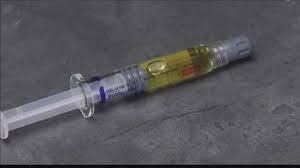This opioid addiction drug is rarely misused. So why is there so much regulation?
Buprenorphine, an important drug in fighting the opioid crisis, has long been closely monitored over concerns it would be abused. But a first-of-its-kind government oversight report released Thursday finds Medicare recipients rarely misuse the drug, which is considered an underused tool to treat opioid addiction and stem overdose deaths.
Less than 1% of Medicare recipients potentially misused or diverted the opioid-substitute medication in 2021, according to the report from U.S. Department of Health and Human Services inspector general investigators.
The report concluded buprenorphine is “critical to addressing the nation’s opioid crisis" but likely isn't prescribed enough. Fewer than 1 in 6 Medicare enrollees who are addicted to opioids take the medication even as drug overdose deaths soar.
Earlier this year, the U.S. Drug Enforcement Administration sought to require people to visit a doctor or clinic within 30 days of getting a telehealth prescription for controlled substances such as buprenorphine. However, the DEA announced last week it would postpone the proposal and extend a COVID-19 pandemic policy allowing remote prescribing through Nov. 11.
HHS inspector general analysts declined to comment on the DEA proposal but said Thursday's report provides evidence that Medicare recipients rarely misused the drug in 2021 while the pandemic's remote prescribing was in effect. Furthermore, analysts say HHS should take steps to make buprenorphine available to people with opioid-use disorder, particularly as more than 100,000 people died last year from drug overdoses.
“Access to buprenorphine is extremely important,” said Miriam Anderson, a social science research analyst at HHS inspector general. “It can save lives and now can be widely prescribed by many health care providers.”
What is buprenorphine?
The National Institute on Drug Abuse says people use buprenorphine mainly to reduce cravings and ease withdrawal symptoms from opioids, whether prescription painkillers or illegal substances such as heroin or illicit fentanyl. People can overdose on buprenorphine, but the risk is much lower than those who are on opioids, according to NIDA. Drugs such as buprenorphine are classified as controlled substances based on the potential for abuse or misuse.
How federal policies on opioid substitute drugs are changing
Federal policies are evolving on how to balance the risk of diversion – when drugs are used or resold inappropriately – while ensuring people with opioid-use disorder can get the medication.
Federal legislation passed in 2000 required doctors to register with the Substance Abuse and Mental Health Services Administration and undergo training to prescribe the medication. Doctors and advocacy organizations said the so-called "X waiver" limited the number of prescribers. One report found just 5% of doctors prescribed the drug.
But the Mainstreaming Addiction Treatment Act of 2023, signed by President Joe Biden last December, eliminated the waiver requirement for doctors and other clinicians who prescribe the drug. In other words, doctors who register with the DEA are free to prescribe the medication if they choose to do so.
The inspector general said its findings, including the low rate of buprenorphine misuse, "support the recent repeal of the waiver." With opioid overdose deaths near all-time highs, the inspector general urged HHS and the Centers for Medicare & Medicaid Services "use all tools at their disposal to address the crisis."
How often is buprenorphine misused?
Inspector general investigators focused on finding fraud, waste and abuse in buprenorphine prescribing. Despite concerns the drug is prone to diversion, investigators found little evidence that is occurring.
Of the 1.1 million Medicare recipients with opioid-use disorder, 170,408 were prescribed buprenorphine in 2021, of which just 1,245 – or 0.7% – potentially misused the drug due to high dosages or being prescribed opioids while on the substitute drug, the report found, including:
323 were prescribed more than 36 mg per day of buprenorphine − more than 50% higher than the maximum recommended daily dose.
927 received buprenorphine while they were prescribed opioid painkillers. Getting both medications at the same time could mean buprenorphine was misused or patients had doctors who did not coordinate care.
35 doctors or other clinicians had abnormal prescribing patterns. Of those, two doctors ordered high dosages while 33 doctors prescribed buprenorphine for patients on opioids.

What do government oversight investigators want to see?
The inspector general recommended Medicare monitor buprenorphine use and share information with other agencies and partners. This would give health officials and a government committee monitoring overdoses early information about buprenorphine use, prescribing, barriers that prevent people from getting the drug and any signs of misuse.
In a response to the oversight recommendations, the Centers for Medicare & Medicaid Services said such additional monitoring wasn't necessary. The agency said it already tracked drug spending and prescribing patterns that can detect potential problems. The agency added that the inspector general's report showed buprenorphine misuse is low and doesn't raise an investigative concern.
The inspector general also recommended Medicare:
Inform doctors about the low risk of buprenorphine misuse and encourage them to treat more people with opioid-use disorder.
Share information about versions − such as Suboxone − that combined buprenorphine with naloxone, the overdose reversal drug. These combination drugs are less likely to be misused.
Review and take action on the small number of prescribers with concerning patterns.
This study looked at Medicare. How does that translate to younger adults?
Medicare is a federal health program for adults over 65, but it also covers younger adults with disabilities. In fact, about half of Medicare recipients with opioid-use disorder are younger than 65.
The study looked at buprenorphine use among 50 million people with Part D prescription drug coverage. An estimated 2.1 million Americans have opioid-use disorder.
What does other research say about buprenorphine?
Buprenorphine overdose deaths have not increased even as the drug has become more widely available during the nation's addiction crisis, said Kevin Roy, chief policy officer with Shatterproof, a nonprofit that addresses addiction treatment.∎
He said the inspector general report echoes research that showed buprenorphine misuse is low.
"There's a growing body of evidence that the risks of buprenorphine diversion are fairly limited and offset by the benefits of access to this treatment," Roy said. "Policy should be geared toward access to treatment whenever possible."
Ken Alltucker is on Twitter at @kalltucker, or can be emailed at alltuck@usatoday.com

This article originally appeared on USA TODAY: Opioid substitute buprenorphine is rarely misused: Medicare report

